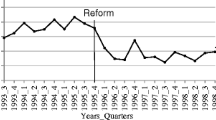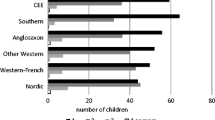Abstract
This paper discusses how childcare and parental leave policies affect female employment by reviewing the international evidence and recent papers on Japan. These papers estimate causal effects of policies by exploiting policy changes, which is a more credible identification strategy than those applied in earlier observational studies. The literature on parental leave finds that a more generous leave package tends to delay mothers’ return to work, but it does not have detrimental effects on maternal labour supply in the medium to long run. Some papers also find that provision of job protection for around 1 year can increase maternal employment, but longer job protection has little additional effects. The literature on childcare policies finds that maternal employment does not necessarily increase, because the expansion of childcare may crowd out informal child-care arrangements, such as care provided by grandparents. Findings by recent papers on Japan are largely consistent with the international evidence.
Similar content being viewed by others
References
Abe, Y. (2013) “Regional Variations in Labor Force Behavior of Women in Japan”, Japan and the World Economy, Vol. 28, pp. 112–124.
Asai, Y. (2015) “Parental Leave Reforms and the Employment of New Mothers: Quasi-Experimental Evidence from Japan”, Labour Economics, Vol. 36, pp. 72–83.
Asai, Y, R Kambayashi and S. Yamaguchi (2015) “Childcare Availability, Household Structure, and Maternal Employment”, Journal of the Japanese and International Economies, Vol. 38, pp. 172–192.
Asai, Y, R Kambayashi and S. Yamaguchi (2016) Crowding-Out Effect of Subsidized Childcare, Hamilton, ON: McMaster University.
Baker, M., J. Gruber and K. Milligan (2008) “Universal Child Care, Maternal Labor Supply, and Family Well-Being”, Journal of Political Economy, Vol. 116, No. 4, pp. 709–745.
Baker, M. and K. Milligan (2008) “How Does Job-Protected Maternity Leave Affect Mothers’ Employment?”, Journal of Labor Economics, Vol. 26, No. 4, pp. 655–691.
Baum, C. I. (2003) “The Effect of State Maternity Leave Legislation and the 1993 Family and Medical Leave Act on Employment and Wages”, Labour Economics, Vol. 10, No. 5, pp. 573–596
Berlinski, S. and S. Galiani (2007) “The Effect of a Large Expansion of Pre-Primary School Facilities on Preschool Attendance and Maternal Employment”, Labour Economics, Vol. 14, No. 3, pp. 665–680.
Blau, D. and J. Currie (2006) “Pre-School, Day Care, and After-School Care: Who’s Minding the Kids?”, in E. A. Hanushek and F Welch, eds, Handbook of the Economics of Education, vol. 2, North-Holland: Elsevier, pp. 1163–1278.
Blau, D. M. and P. K. Robins (1988) “Child-Care Costs and Family Labor Supply”, The Review of Economics and Statistics, Vol. 70, No. 3, pp. 374–81.
Cascio, E. U. (2009) “Maternal Labor Supply and the Introduction of Kindergartens into American Public Schools”, Journal of Human Resources, Vol. 44, No. 1, pp. 140–170.
Connelly, R. (1992) “The Effect of Child Care Costs on Married Women’s Labor Force Participation”, The Review of Economics and Statistics, Vol. 74, No. 1, pp. 83–90.
Fitzpatrick, M. D. (2010) “Preschoolers Enrolled and Mothers at Work? The Effects of Universal Prekindergarten”, Journal of Labor Economics, Vol. 28, No. 1, pp. 51–85.
Fitzpatrick, M. D. (2012) “Revising Our Thinking About the Relationship Between Maternal Labor Supply and Preschool”, Journal of Human Resources, Vol. 47, No. 3, pp. 583–612.
Gelbach, J. B. (2002) “Public Schooling for Young Children and Maternal Labor Supply”, American Economic Review, Vol. 92, No. 1, pp. 307–322.
Golosov, M., L. E. Jones and M. Tertilt (2007) “Efficiency with Endogenous Population Growth”, Econometrica, Vol. 75, No. 4, pp. 1039–1071.
Goux, D. and E. Maurin (2010) “Public School Availability for Two-Year Olds and Mothers’ Labour Supply”, Labour Economics, Vol. 17, No. 6, pp. 951–962.
Havnes, T. and M. Mogstad (2011) “Money for Nothing? Universal Child Care and Maternal Employment”, Journal of Public Economics, Vol. 95, No. 11, pp. 1455–1465.
Higuchi, Y. (1994) Empirical Analysis of Parental Leave Legislation. Tokyo: University of Tokyo Press, Modern Families and Social Security.
Higuchi, Y., T. Matsuura and K. Sato (2007) [“Effects of Regional Factors on Fertility and Employment Continuity of Wives”], RIETI Discussion Paper No. 07-J-012. (In Japanese.)
Imada, S. and S. Ikeda (2006) [“Effects of Parental Leave Legislation on Employment Continuity for Mothers and Work-Life Balance”], Nihon Rodou Kenkyu Zasshi, Vol. 553, pp. 34–44. (In Japanese.)
International Labour Office (2014) Resource Guide on Gender Issues in Employment and Labour Market Policies, Geneva: Instructional Material.
Kimmel, J. (1998) “Child Care Costs as a Barrier To Employment for Single and Married Mothers”, The Review of Economics and Statistics, Vol. 80, No. 2, pp. 287–299.
Lalive, R., A. Schlosser, A. Steinhauer and J. Zweimuller (2014) “Parental Leave and Mothers’ Careers: The Relative Importance of Job Protection and Cash Benefits”, Review of Economic Studies, Vol. 81, No. 1, pp. 219–265.
Lalive, R and J. Zweimüller (2009) “How Does Parental Leave Affect Fertility and Return to Work? Evidence from Two Natural Experiments”, The Quarterly Journal of Economics, Vol. 124, No. 3, pp. 1363–1402.
Lefebvre, P. and P. Merrigan (2008) “Child-Care Policy and the Labor Supply of Mothers with Young Children: A Natural Experiment from Canada”, Journal of Labor Economics, Vol. 26, No. 3, pp. 519–548.
Michalopoulos, C., P. K. Robins and I. Garfinkel (1992) “A Structural Model of Labor Supply and Child Care Demand”, Journal of Human Resources, Vol. 27, No. 1, pp. 166–203.
Ministry of Health, Labour and Wealth (2009) Summary of the Survey of Local Child Welfare Services. [Cited 25 July 2012.] Available from URL: http://www.mhlw.go.jp/toukei/saikin/hw/jidou/09/dl/80.pdf
Nihon-Jidou-Mondai-Chousakai (1978) Jidou Fukushi Sanjuu Nennno Ayumi (30 Years of Child Welfare). Tokyo: Division of Children and Family, the Ministry of Welfare.
Nollenberger, N. and N. Rodriguez-Planas (2015) “Full-Time Universal Childcare in a Context of Low Maternal Employment: Quasi-Experimental Evidence from Spain”, Labour Economics, Vol. 36, pp. 124–136.
Ruhm, C. J. (1998) “The Economic Consequences of Parental Leave Mandates: Lessons from Europe”, The Quarterly Journal of Economics, Vol. 113, No. 1, pp. 285–317.
Sato, K. and X. Ma (2007) Effects of Parental Leave Reform on Female Employment, Keio University Press, Vol. 4 of Dynamics of Household Behavior in Japan, Tokyo.
Schonberg, U. and J. Ludsteck (2014) “Expansions in Maternity Leave Coverage and Mothers’ Labor Market Outcomes after Childbirth”, Journal of Labor Economics, Vol. 32, No. 3, pp. 469–505.
Schoonbroodt, A. and M. Tertilt (2014) “Property Rights and Efficiency in OLG Models with Endogenous Fertility”, Journal of Economic Theory, Vol. 150, pp. 551–582.
Shigeno, Y. and Y. Ookusa (1998) [“Effects of Parental Leave Legislation on Marriage and Employment Continuity”], Nihon Roudou Kenkyu Zasshi, Vol. 40, No. 9, pp. 39–49. (In Japanese.)
Shigeno, Y and Y Ookusa (1999) [“The Effects of Childcare Policy on Fertility and Employment”], Kikan Shakai Hosho Kenkyu, Vol. 35, pp. 192–207. (In Japanese.)
Suruga, T. and K. Cho (2003) [“Effects of Parental Leave Legislation on Childbearing and Female Employment”], Kikan Kakei Keizai Kenkyu, Vol. 59, pp. 56–63. (In Japanese.)
Unayama, T. (2011) [“Compatibility of Marriage, Fertility, and Work and Childcare Availability”], Nihon Keizai Kenkyu, vol. 65, pp. 1–22. (In Japanese.)
Waldfogel, J. (1999) “The Impact of the Family and Medical Leave Act”, Journal of Policy Analysis and Management, Vol. 18, No. 2, pp. 281–302.
Yamaguchi, S. (2016) Effects of Parental Leave Policies on Female Career and Fertility Choices. Hamilton, ON: McMaster University.
Yamakawa, R. (2007) From Security to Mobility? Changing Aspects of Japanese Dismissal Law. Seattle, WA: University of Washignton Press, pp. 483–520.




